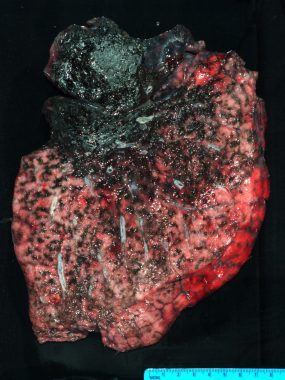Pneumoconioses

Lung of former coal miner with severe black lung.
The pneumoconioses are a group of lung diseases caused by the lung’s reaction inhaling certain dusts. The main cause of the pneumoconioses is work-place exposure. Environmental exposures have rarely been related to these diseases. The primary pneumoconioses are:
- Abestosis – caused by inhaling asbestos fibers
- Silicosis – caused by inhaling silica dust
- Coal workers’ pneumoconiosis (commonly referred to as CWP or black lung) – caused by inhaling coal mine dust
These three diseases typically take many years to develop. However, rapidly progressive forms of silicosis can occur after short periods of intense exposure. When severe, the diseases often lead to lung impairment, disability, and premature death. From a public health perspective, these conditions are entirely man-made, and can be avoided through appropriate dust control.
Other forms of pneumoconioses can be caused by inhaling dusts containing:
- Aluminum
- Antimony
- Barium
- Graphite
- Iron
- Kaolin
- Mica
- Talc
There is also a form called mixed-dust pneumoconiosis. Overall, most physicians do not encounter these diseases very frequently. Byssinosis, caused by exposure to cotton dust, is sometimes included among the pneumoconiosis. Although the pattern of lung abnormality in Byssinosis is different from the pneumoconioses listed above.
The 1995 NIOSH publication Criteria for a Recommended Standard – Occupational Exposure to Respirable Coal Mine Dust established a recommended exposure limit (REL) for coal mine dust. In 2011, NIOSH published a Current Intelligence Bulletin that updated the information on coal mine dust exposures and associated health effects from 1995 to the present. In 2012, the Government Accountability Office (GAO) reviewed the analytical methods used by NIOSH to establish its REL. GAO’s Reports and Key Studies Support the Scientific Conclusions Underlying the Proposed Exposure Limit for Respirable Coal Mine Dust found these analytical methods were appropriate and achieving the NIOSH REL would reduce miners’ risk of respiratory disease over a working lifetime.
Pneumoconiosis Identification and Classification
The pneumoconioses are typically detected through radiological imaging. Traditionally, this has been chest x-rays taken on film. However, digital computer technology is increasingly being used. The International Labor Office (ILO) provides guidelines for classifying radiographs of the pneumoconioses. NIOSH operates the B Reader Program. This program allows physicians to document their proficiency in classifying radiographs (using ILO guidelines) by taking an examination.
Medical Monitoring for the Pneumoconioses
NIOSH operates the Coal Workers’ Health Surveillance Program (CWHSP), which was mandated by the 1969 Federal Coal Mine Health and Safety Act. This program is intended to prevent coal workers’ pneumoconiosis by detecting the disease early and voluntary mine transfer to low dust jobs.
Guidance on radiological classification methods and practices in worker monitoring for the pneumoconioses is provided on NIOSH’s Chest Radiography page.
